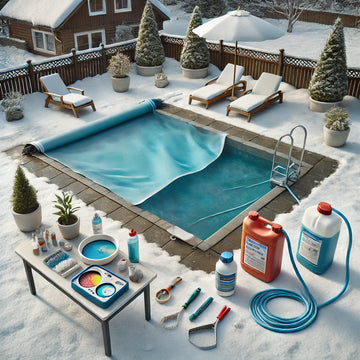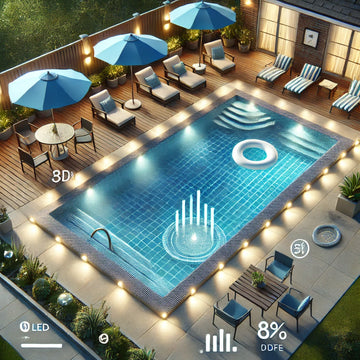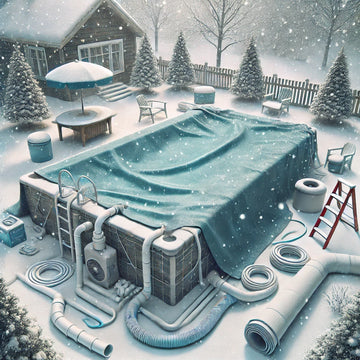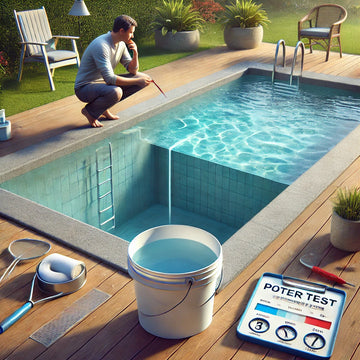Pool Maintenance Tips To Prevent & Treat Green Pool Water
The Canadian government recommends a minimum level of one to three ppm of sanitiser in your pool. Closing inground pools improperly can leave these levels much lower which makes preventing green pool problems near impossible.
In this article, we discuss winter maintenance for pools and how to overcome problems with green pool water. Continue reading to learn how to get your pool looking great.
Why Is My Pool Green?
If you’re dealing with green pool water, you need inground pool maintenance. Green pool water is evidence of algae growth. This is problematic to your health and is also unsightly.
Maintaining Pool Chemical Balance
One of the best ways of preventing green pool problems is to perform regular inground pool maintenance including maintaining the chemical balance. Getting the right pool cleaning equipment is a good place to start.
Expert Pool Closing Services
The best and easiest way to keep up with inground pool maintenance is to hire professionals. Professionals ensure that every step of closing inground pools is done correctly. You don’t have to worry about whether you made a mistake if you choose to DIY.
Check The Chemical Balance
When cleaning inground pools, take the time to check the chemical balance with a pool testing kit. The kit is an essential piece of pool cleaning equipment.
It contains a guide that will show you normal values and compare them to the values from your pool water. You can make adjustments as needed.
Add More Winter Chemicals
Winter maintenance for pools is an essential part of closing inground pools. However, pool chemicals only last approximately five months in the water. For this reason, consider adding more chemicals in late winter before the pool freezes, or in early spring – right after the ice is melted.
What Happens To Algae During Winter?
After closing and cleaning inground pools, temperatures start to drop. The colder weather helps with preventing green pool problems but it doesn’t completely solve them. Warmer days can lead to algae growth without proper inground pool maintenance.
How To Deal With A Green Pool In The Spring
When spring arrives, opening your pool to the sight of green water is frustrating. Fortunately, there are a few steps you can follow to get your water crystal clear again.
-
Determine The Severity Of The Algae Blooms
The first step in cleaning inground pools with algae blooms is to determine the severity of it. There are different types of algae that require different pool treatments. Understanding what’s growing in your pool will help you decide how to treat it.
The most common types of algae are green, yellow, and black. While green is the most common reason for cleaning inground pools, yellow and black sometimes occur as well. The latter two are more resistant to standard chlorine.
-
Test The PH Levels
If you want to avoid overly cloudy water after ridding yourself of the algae, check your pH before and after treating it. The ideal pH range is between 7.2 and 7.6. The water should be below this point before shocking it.
-
Backwash The Filter
If you haven’t been successful at preventing green pool problems, backwashing the filter, or cleaning/replacing the cartridges can help. This helps remove built-up debris and oils that contribute to algae growth. The process varies depending on your type of filter.
-
Shock The Pool
Shocking your pool destroys algae while shocking as part of winter maintenance for pools keeps it from returning. The amount of calcium hypochlorite you need depends on the size of your pool, the type of algae, and your current chemical levels.
-
Brush The Pool
Brush any accumulations of algae that are attached to the pool bottom and walls. This helps to loosen the material so it can move through the filter in the next step – vacuuming. It’s important to brush your pool first, to avoid live algae sticking to your vacuum or clogging up the filter.
-
Vacuum Your Pool
You should always wait until the algae are dead before vacuuming! A good indication is when the algae turn grey. Then you can turn off the pump (sparkle) to make the dead algae fall to the bottom of the pool. Cleaning inground pools with a vacuum help make the next steps easier and more effective. This should be done immediately after shocking. (it should be the reverse, you should brush the wall then vacuum one’s the algae are dead
-
Turn On The Filter
The pool may still be cloudy but it should no longer be green. The next step is to turn on your pool filter to remove any small bits of algae or debris remaining. At this point, you can use the clarifier to speed up the recovery.
-
Maintain Your Pool
Once you have a basic understanding of closing inground pools, you need to dedicate focus on maintaining it and preserving your efforts. This means cleaning filters regularly and using a reliable chlorinating system to prevent green pool problems.
Be Proactive About Other Common Winter Maintenance Issues
Waiting until spring to perform inground pool maintenance can be a time-consuming mistake. If you want to minimize algae growth and keep your pool looking great, learn about winter maintenance for pools.
Once you know what problems to keep an eye out for, you’ll be able to act on them faster if they occur. This can save you a lot of time and money when you open your pool for the season.
Closing Your Pool For The Winter
Closing inground pools involves removing all accessories, balancing pool chemicals, lowering the water level, and adding blowing-out water lines. Now, it’s possible to close most of the pools with the water level at a standard height, without lowering the water level!
Closing Inground Pools
Closing inground pools and preventing green pool problems is a lot of work. While the above guide can help make the process more manageable, working with professionals is the easiest option for inground pool maintenance.
If you want to make cleaning inground pools as easy as possible, contact us today to request an appointment.




